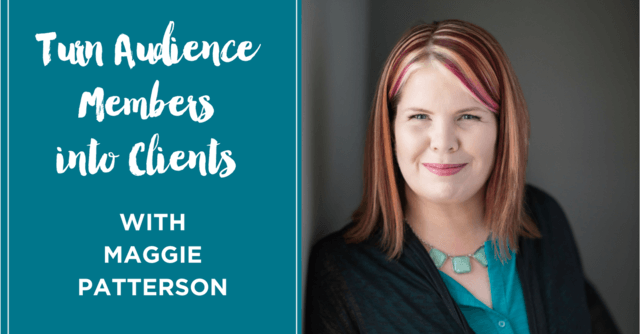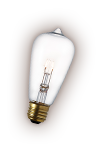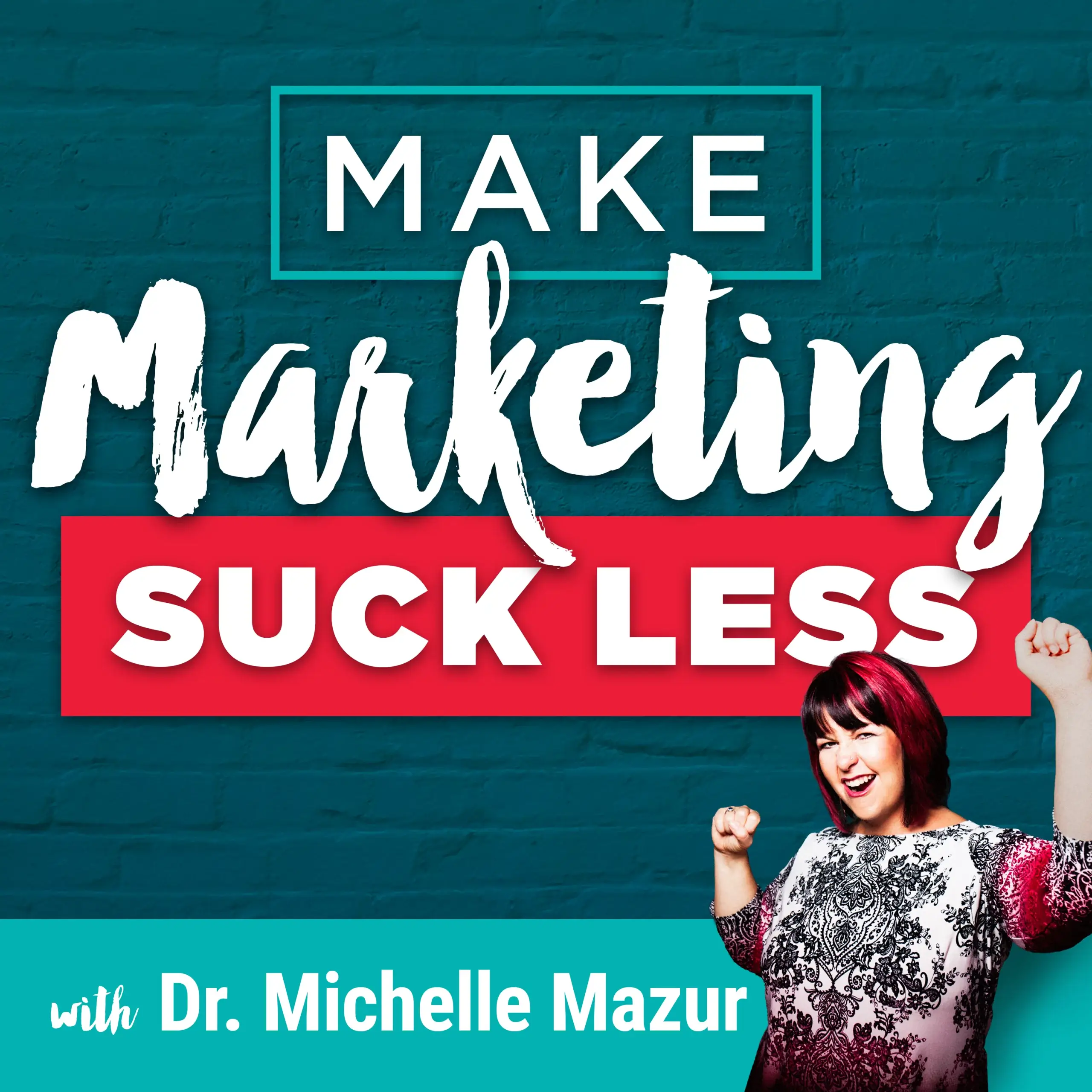Make Marketing Suck Less
How to Turn Audience Members into Clients Using Funnels with Maggie Patterson
By Michelle Mazur > May 30, 2017
Filed Under Guest Speaker

You know that I talk about making money with speaking in two different ways. There's paid speaking and then there are client attraction speeches.
Client attraction speeches have nothing to do with selling from the stage.
Instead, you create a speech that's aligned with your business, you do a bang-up job delivering it, and then you offer something completely free so that people give you their email addresses.
I know one thing that people struggle with is, “Great, I've got their email, now what do I do?”
This is where our guest expert Maggie Patterson comes in.
Maggie is a Communications Strategist and Chief Marketing Officer at Scoop Industries with 15 years of experience, 11 of which as a self-employed consultant. That's impressive. Maggie has spent her entire career working in client-facing roles and marketing and as a copywriter. Today she works with service-based business owners to help them implement smart strategies for business growth, including today's topic, funnels.
If you don't know what a funnel is, don't let the word scare you off.
Maggie is going to explain what a funnel is and how to create one for your business.

Prefer to Listen?
Maggie: I always feel so fancy after my bio it's like, “Yeah, it's just me.”
Michelle: Well, you are fancy.
Maggie: Apparently, I am very fancy, but thank you for having me. I'm excited to talk about funnels.
Michelle: Yes, because that is where a lot of my clients get stuck. They're like, “Okay, I have this client attraction speech, I'm offering up some kind of lead magnet, or a consult where I get their email,” and then they don't know what to do next. I always turn to you when I'm thinking about how to nurture relationships so that they become clients. Let's start with what's a funnel?
What is a funnel?
Maggie: Okay. Let's just demystify this right now. If you work in the online world, or if you read anything in marketing, they will talk a lot about the funnel. It's a nomenclature that, I think, confuses a lot of people.
Essentially it's a sequence of steps to get people from point A to point B. It can be email, or something else, but the idea is that every step of the way you're narrowing the field. You're getting people closer to raising their hand to say, “Yes, please, let me work with you,” or “I want to buy your thing,” whatever the case is.
Don't let the idea of the funnel scare you. The reason it's called a funnel is that it acts just like a funnel. Just like if you're funneling oil into a jar. Think of it as a series of steps that allow people to make a decision every step of the way.
If you're talking about it from an email point of view, we might be selling in that funnel, we might be onboarding in that funnel.
Most of all, if you're doing a client attracting speech you want to move them from interest to raising their hand and wanting to work with you, or really taking that next step with you. You're not just going to do that with one email that says, “Hey, buy my thing!”
Michelle: “Hey, you should work with me!” “You loved my speech, now love working with me.” Yeah. It sounds like it's really about building a relationship with the other person.
Maggie: Yeah, completely. I'm sure this is not new to anyone but in marketing, we talk about the know-like-trust factor.
Essentially by setting up an email funnel, you want to bring people through getting to know you, and your service, and what you have to offer.
Then onto getting to like you, because we do business with people we like. We don't do business with people we don't like. In fact, anytime I've done business with people I don't like, it didn't end well.
Michelle: Yes, Don't do that.
Maggie: Then we show them they can trust you. Trust is that last component before they're going to say, “Yes.”
They need to know that you're going to do what you say you're going to do. They need to trust that you can deliver the results you've been talking about.
When you plan out an email funnel think about how you can go from know-like-trust before you make the offer. Before you come in and go, “Hey, by the way, I can help you with the thing.” Because by the time you get around to making the offer, you want them to have already decided yes or no. You don't want them feeling wishy washy.
Michelle: Oh okay. With speakers, it sounds like there's a ton of different types of funnels that we could possibly implement. If you're doing a client attraction speech, what type of funnels do the speakers need?
Nurture Funnels for Speakers Doing Client Attraction Speeches
Maggie: I really see two types of funnels. Let's say, you're doing a lot of speaking and you're at the point where you aren't necessarily taking on a lot of new clients right now, or you don't have a specific offering so there's no real need there, but you're doing it more for visibility. You're probably gonna set up what's called a nurture funnel.
People tend to sign up for your mailing list when they are the most excited about you. They just saw you on stage. They are ready to learn more and get to know you. They've essentially said, “Yes, please, send me more information.”
They've given you their coveted email address. You want to be able to build that relationship with them, let them get to know you, let them get comfortable with you.
Frequently a nurture funnel will start with an email that says, “Thanks for joining my list.”
Then their name is placed on your list, perhaps a newsletter list, for example.
But you don’t want to just throw them in there without knowing what they are getting into. So we ease them into it. I always say it's like college. You don't just show up on campus and they're like, “Go!” They have an orientation week, they have a freshman week, they have something to get you prepared. That's what your nurture funnel should really be doing: preparing them for what comes next.
Hybrid Funnel = Nurture + Sales Funnel
Now let's say you already have that funnel. The other type of offer is kind of a hybrid funnel.
It's a combination between a nurture funnel and a sales funnel. You're basically going to take those two and put them together you're going to nurture, get them to know-like- trust, and then you're going to start selling on the back end.
Michelle: Awesome. Actually, that leads me to my next question, and since I'm the host of the show, I get some free coaching. Let's say I have a speech where I offer a freebie that is completely aligned with the speech. It takes people deeper into the subject matter. I've just given the speech, people love me, they are super excited, they sign up in droves to get the freebie, my little lead magnet.
What is my next step? How should I best follow up with them? How would you coach me through writing some emails, so that I keep them engaged and turn them into clients?
Maggie: Okay. The one point of disconnection that commonly happens is you'll do the speech, you'll have that lead magnet, and then the thread doesn't follow through.
The same way you're going to create that cohesive start to finish story, or that loop in a speech, you want to create that same kind of loop in your emails.
You want to make sure that that next thing in the funnel continues with that narrative. It's basically a plot or a storyline that you want to keep moving forward.
For example, say you are using your “Unfair Speaking Advantage” lead magnet. Instead of just throwing them into a nurture funnel, which isn't really connected to the speech they just heard. The content of the emails in your funnel should relate to your Unfair Speaking Advantage.
You could talk about things like why this is important? Why does this matter? What do you need to know to get started?
You really want to give them the tools to be successful, so they can really picture themselves taking that next step. So many times with the funnel, too,
You will see people create emails that say, “Here's all my blog posts, good luck!” No, that doesn’t work. You want the people who signed up for your list to feel like, “Yes, they've taken me by the hand, they're going to take me to this next step so that they're really, really clear on what should happen next.”
Providing great content is important, but you want to make sure that that story line remains intact from start to finish. If point A in your funnel is being on stage, then it's in the lead magnet, then it's in all the emails: make sure that same thread goes through everything.
Michelle: Yeah. So if I'm talking about the Unfair Speaking Advantage on stage, then that's my opt in or my lead magnet. Then I need to continue talking about it through the emails that I send, and then that naturally leads to my offer.
Maggie: Exactly. People often fear repetition. Repetition in your market is reinforcement. Not everyone reads every single thing you put out, and that dedicated few that do, they love everything you say, so you can say it again.
Michelle: It's funny because I also have speakers ask me, “Well if I have a signature talk and somebody has heard it before, isn't that bad if they're in my audience again?” But I tell them, “No, because they're probably going to remember one or two points, if you're lucky, things that you said during that talk. They're not going to remember the entire talk, so yes, you can give it again. It's always a good reminder, or they get something else out of it.” Yeah, repetition is good. I agree.
Maggie: It just keeps it simpler for you. You don't have to be over the top, you've got the story line, just follow it through. Help them get to that next stage and where you want them to be.
Michelle: Awesome. I know that since we are talking about email and email marketing people are probably thinking, “Okay, this sounds great, I could write some emails that go along with the speech, that nurtures them into the offer, but how do I deliver that?” Let's talk tech. If I am not at all tech savvy, what do you recommend to set up this type of nurturing/sales funnel?
Funnel Technology
Maggie: Okay. I can't even be a technology agnostic for this answer, if you are not super tech savvy, the easiest thing you can use is ConvertKit. It's an email marketing platform, it's extremely affordable, depending on how many contacts you have. Most of all, it's easy to understand.
ConvertKit is setup to manage exactly this type of thing, and it provides a level of functionality that providers like MailChimp just don't do at a relatively low price point. It also provides the kind of striped down features that you need without getting into an Infusionsoft or Ontraport or HubSpot, or something much bigger.
Michelle: Yeah. I use ConvertKit for my email marketing and I trained my VA how to use it in 20 minutes. We hopped on Skype, I showed her my screen, and I took her through how I wanted her to do it. It is definitely set up so that you can create great funnels.
You know after your speech, the first thing you want to do is deliver your lead magnet. What really ticks me off is when a speaker takes my email address and then doesn't deliver the lead magnet. You want to enter them into your email marketing, or your ConvertKit, and then you put them into the sequence, which delivers all of these emails automatically. Once you have set it up, you never have to think about it again …
Maggie: Yeah. I'm fairly technical. I come from working in the tech industry, but I had never been in Convert Kit. I got in there and set something up for a client, no problem! I did have my business partner who's the tech guru go through and check it. She said, “Yup, you're totally good.” It's literally that easy, that you can go in blind.Or there are lots of people you can hire to help you with Convert Kit.
Michelle: That's true.
Maggie: It's not like you're gonna be stuck out in the streets going, “I don't know what I'm doing.”
Michelle: Yeah. ConvertKit is definitely worth checking out, because you have to have a way to take people from being audience members, who are crazy in love with you, to people who want to work with you. Setting up that nurture funnel is the best way to do that and Convert Kit takes all the tech work out of it. Maggie, where can we find you online?
Maggie: The best places to find me online are, if you're a podcast listener, you can find the Inside Scoop Podcast. We're on iTunes, Stitcher, soon to be on some others. You can also find us at Scoopindustries.com, and if you really are keen to get started with funnels, we do have a very streamlined course, Michelle has taken it, called Funnel School.
Michelle: Yes, Funnel School was amazing. It really helped me get my own funnels into place for my business. Thank you so much, Maggie, for being on the show! You gave us some actionable insights that people can start applying right now. Yes!
Maggie: Well, thank you for having me. I love talking about funnels, I'm so nerdy.
Michelle: Yes, for rebel nerds. All right.
Create Your One-of-a-Kind Message
Your 3 Word Rebellion is the Key to Growing Your Business & Impact






